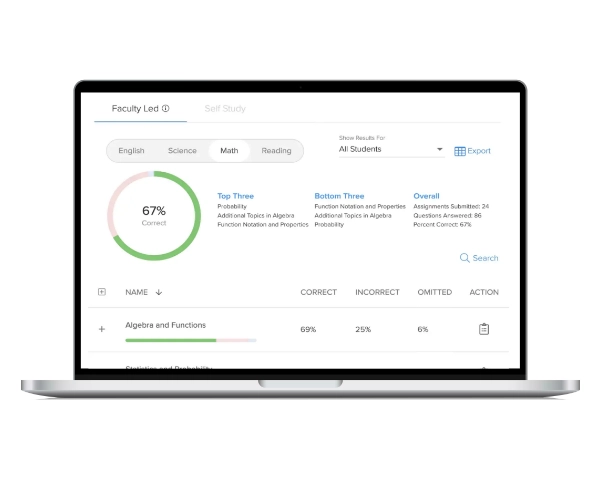Helen Keller once said, “Alone, we can do so little; together, we can do so much.”1 This idea, this sense of community, is the very essence of why AP® program outreach is so important. It takes more than just a great AP teacher to support their students’ success. The process of getting students ready for college through an AP program reaches far beyond the classroom.
To help AP students thrive, there needs to be a strong foundation built around the connection between AP teachers, administrators, students, and parents. Boosting community outreach and parent communication within your school’s AP program matters, and to strengthen that sense of AP community requires breaking free from the usual academic rules.
Understanding the AP Community
The AP community is a collaborative team that extends beyond students, teachers, parents, and administrators—it’s a finely tuned mechanism where each member plays a distinct role. Effective teamwork and AP communication among teachers, parents, students, and administrators maximize the team’s potential, fostering academic and personal growth. Diverse contributors, including teachers, students, parents, administrators, counselors, support staff, and community partners, collectively contribute to the success of the Advanced Placement® program. This collaborative effort creates a dynamic environment focused not only on academic achievement but also on molding students into well-rounded individuals, promising a fulfilling educational journey.
Strategies for High School Administrators
Nurturing a successful AP program requires thoughtful measures. There are several strategies administrators can use to do this, such as creating a supportive atmosphere, offering necessary resources, and promoting professional development.
Foster an openly supportive environment
Administrators are, in a way, the architects of a school’s AP program, constructing a welcoming space for students, teachers, and parents. Actively participating in AP events symbolizes a tangible commitment to academic excellence. Creating a supportive atmosphere requires effective communication, including regular updates on program developments, important dates, and policy changes. Transparency in addressing concerns builds trust. Actively seeking feedback showcases dedication to continuous improvement. Recognizing achievements through awards ceremonies or sharing success stories contributes to a positive culture, emphasizing the enduring benefits of engaging in the AP program.

Provide resources
Strategic allocation of resources reinforces the foundation of AP courses, ensuring educators have access to the tools they need. Whether these tools are up-to-date textbooks or cutting-edge technology, they create an environment conducive to advanced learning. Designating appropriate spaces for AP courses enhances the sense of community. Additionally, encouraging parent involvement through informative sessions, workshops, and meaningful connections enriches the educational experience. Cultivating partnerships with local colleges, businesses, and educational organizations can create networking resources, empower individual students, and contribute to the unity and vitality of the entire AP community.
Professional development
Encouraging administrators to engage in AP professional development is a game-changer. It plants seeds for a culture of perpetual improvement and keeps leadership informed about the evolving landscape of the AP program. Supporting AP teachers with continuous learning opportunities and fostering collaborative learning among them creates a community of brilliance. This approach elevates the entire AP experience, paving the way for a learning environment that’s not just productive but downright exceptional.

Strategies for AP Teachers
Creating a thriving AP community involves intentional efforts by teachers as well. Here, we explore key strategies for AP teachers, emphasizing the pivotal role of open communication, collaborative conferences, and engaging projects in building a unified and enriching high school AP experience.

Open AP communication channels
Effective AP communication is pivotal for building strong connections between high school educators, AP students, and parents. Using various strategies, such as regular class updates, virtual classrooms, and surveys, AP teachers create an inclusive environment. Transparent communication with parents, informative workshops, and regular office hours contribute to a cooperative relationship. Promoting peer support structures and leveraging social media for dedicated AP communities fosters knowledge exchange. Open communication about course policies also builds trust, while recognition events for achievements motivate AP students. These strategies construct a resilient fabric that disseminates information effectively, forging meaningful connections and contributing to the unified strength of the high school’s AP community.
Parent-teacher conferences
Parent-teacher conferences are opportunities to enrich the school’s AP community. AP teachers navigate these conferences like collaborative performances, sharing insights into each student’s academic journey, celebrating highs, addressing challenges, and creating personalized roadmaps. Collaborating with parents to set goals is a commitment to jointly champion student success. Demystifying the academic intricacies of the AP program is about spotlighting benefits and fostering a clear understanding. Picture this as a stage to applaud not just individual but collective achievements, instilling motivation for even greater accomplishments. Proactively addressing concerns, promoting parent involvement, and offering academic resources signify a collective effort.
Collaborative projects
Community outreach projects offer real-world applications, connecting education to practical scenarios. Ensuring inclusive group dynamics allows all students to contribute their unique strengths. Collaboration with professionals adds valuable insights, showcasing projects through events to acknowledge student accomplishments. Utilizing digital tools prepares students for future collaboration, enhancing critical thinking skills with practical applications. Reflective assessments encourage self-awareness and teamwork skills. Encouraging parent involvement in projects strengthens the school-home connection. Collaborative research opportunities with local universities or industry professionals broaden learning horizons. These initiatives contribute to the creation of a dynamic and inclusive AP community.
Using Technology for Better AP Engagement, Communication, and an Opportunity for Feedback
When fortifying AP community ties, the strategic use of technology can be integral. High schools can seamlessly integrate online platforms, thoughtfully crafted email updates, and a well-maintained social media presence. Providing comprehensive training for both educators and parents ensures the effective and user-friendly implementation of these tech tools for collaborative communication. Robust feedback channels involving parents, students, and teachers remain essential for continuous improvement. High schools can adeptly use an online learning management system (LMS) for AP communication and engagement (e.g., Google Classroom, Canvas, Blackboard, etc). This could be a centralized online hub for assignments and updates, breaking down geographical barriers with virtual meetings, and real-time mobile app notifications for parents on the go. Email newsletters can also serve as a reliable channel for updates, while online grade portals promote transparency and a collaborative approach to student success.

Key Takeaways
Strengthening AP community engagement and parent communication is vital for the success of a school’s AP program. Administrators and AP teachers can establish a vibrant community, propelling students toward success while also making a significant impact on students and the overall school culture.
Join UWorld College Readiness on a journey beyond the classroom, fortifying the bonds that define the heart of an AP community.

References
- Ellevate. (2021, February 3). The power of community quotes. Ellevate. https://www.ellevatenetwork.com/articles/8538-quotes-about-the-power-of-community
- The College Board. (2023). Outreach and support resources. AP Central. https://apcentral.collegeboard.org/about-ap/outreach-and-collaborations/outreach-support-resources
- Shewa, N., & Haidari, R. G. (2023, January 25). Community building and parents communication. Strong Schools. https://pressbooks.pub/schools/chapter/community-building-and-parents-communication/




